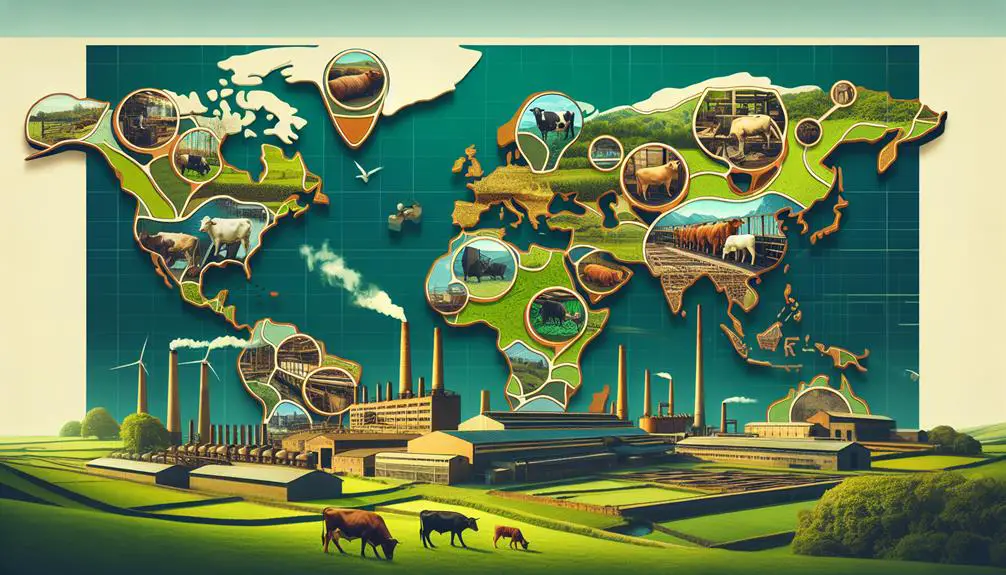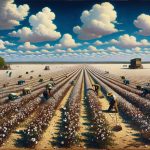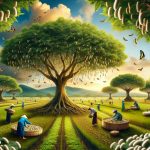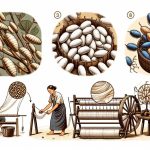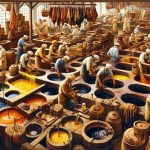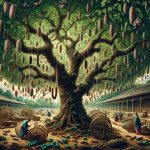I've learned that leather is made all around the world, but the big players are China, Italy, and Brazil. China dominates by producing around 80% of the world's leather goods. Italy is famed for its high-quality, luxurious leather, thanks in part to its long tradition of craftsmanship. Brazil uses its geographical edge to produce a wide range of leather products. Each country uses unique techniques that add to the diversity and quality of the leather produced. There's a lot more to explore about how each type of leather is used and the advanced methods that make this material special.
Table of Contents
Key Takeaways
- Leather is produced globally, with nearly every country involved in its production.
- China, Italy, and Brazil are the leading countries in leather production.
- China accounts for 80% of the world's leather products.
- Italy is renowned for high-quality, luxury leather craftsmanship.
- Brazil benefits from a geographical advantage in the global leather market.
Global Leather Production
Although Italy, China, and Brazil lead the pack, almost every country in the world produces leather. It's fascinating to think about, isn't it? This widespread engagement in leather production isn't just about crafting stylish boots or luxurious couches; it's a major economic powerhouse. Let's dive a bit deeper into why that's the case.
Globally, the leather industry is a lifeline for many. It directly employs about half a million people. That's a huge number, reflecting just how crucial this sector is as an important global employer. Every year, these skilled workers help produce around 24 billion square feet of leather. Imagine that! It's not just a craft; it's a massive operation that spans across continents.
The strategic placement of these production facilities also plays a key role. Having tanneries and production units close to each other helps streamline the entire process, making the supply chain more efficient and responsive. This geographical closeness ensures that products can move from one stage to the next without excessive delays, which in turn helps meet the global demand efficiently. It's clear that leather production isn't just an art—it's a well-oiled machine with significant global impact.
Top Leather Producing Countries
When we talk about leather production, Italy, China, and Brazil really stand out as the top players. These countries are giants in the leather manufacturing industry, and they play a crucial role globally. Let's dive into some specifics.
China, for instance, is the heavyweight here, producing a whopping 80% of the world's leather products. That's a lot of leather! Their massive output primarily supports the demand for finished leather goods both domestically and internationally.
Then there's Italy, renowned for its high-quality leather craftsmanship. Italian leather is synonymous with luxury and is highly sought after in fashion and high-end automotive industries. The expertise and tradition behind Italian leather manufacturing make it a key player in the market.
Brazil also plays a significant role; it's not just about quantity but also about the diversity of leather products. The country's geographical advantage, with its large livestock population, supports its strong position in the global leather market.
Understanding these dynamics is essential because the proximity of these production centers to markets affects the entire supply chain. Efficient supply chains are crucial for timely delivery of finished leather products, impacting everything from production to the retail shelf.
Types of Leather
Let's explore the different types of leather used in various products. From the way raw hides are transformed using various tanning methods, we end up with a diverse range of leather types, each with unique characteristics and uses.
| Type | Source | Characteristics |
|---|---|---|
| Aniline | Top layer of the hide | Minimal finish, shows natural hide beauty |
| Nubuck | Top surface of the hide | Buffed to a soft, velvety touch |
| Full Grain | Top layer of the raw hide | Retains natural marks and characteristics |
| Suede | Flesh side of the hide | Soft, textured, often used for clothing |
Aniline leather is quite special because it's minimally treated, showcasing the natural surface without heavy finishes. This makes it stand out due to its genuine, raw look. On the other hand, nubuck offers a super soft, velvety feel because it's carefully buffed. It's amazing for items where touch is key. Full grain leather keeps the original texture of the hide, making it highly durable and perfect for premium goods. Lastly, suede is all about comfort and texture, crafted from the underside of the hide. Each type of leather, influenced by its tanning and finishing processes, serves different purposes in the world of products, from luxury bags to comfy jackets.
History of Leather Making
I've always been fascinated by how leather making has evolved over the centuries.
From ancient tanning techniques to the formation of medieval leather guilds, each period added its unique touch to the craft.
Now, modern industrial advancements have transformed leather production into a highly efficient process.
Ancient Tanning Techniques
Delving into ancient tanning techniques shows us how leather production has been crucial to many civilizations throughout history. Ancient folks like the Egyptians, Greeks, and Romans figured out how to turn a raw hide or skin into durable, usable leather. They used what was on hand—tree bark, plant extracts, and animal fats—to kick off the tanning process. Each culture had its twist, relying on local resources to get the job done.
This wasn't easy work; it needed a lot of manual labor and real skill to craft high-quality leather goods. Learning about these methods from historical artifacts and old texts really highlights how important leather was—and still is—to human culture. It's fascinating to see how these techniques have evolved over millennia!
Medieval Leather Guilds
Exploring the world of medieval leather guilds, we find that these associations were pivotal in shaping the leather industry during the Middle Ages. These guilds weren't just clubs; they were serious business. They set the rules for leatherworking, making sure that anyone who made leather goods was up to snuff. This was huge because it meant that you could trust that any leather item—be it a belt, bag, or boots—met certain standards of quality.
Guild members were masters of their craft, trained in everything from tanning to dyeing leather. By regulating the trade, these guilds not only boosted the economy of their towns but also turned leatherworking into a respected profession. It's clear that without these guilds, the leather industry wouldn't be what it's today.
Modern Industrial Advancements
As we move into modern times, the leather industry has seen notable advancements that revolutionized its production processes. Here's a quick rundown of some key changes:
- Global Production Shifts: Most of the world's leather now comes from China, making it a central hub for leather manufacturing.
- Advanced Tanning Methods: We've moved from traditional methods to more efficient ones like chrome tanning, which speeds up the process and cuts costs.
- Diverse Source Materials: While historically limited to common livestock, now even exotic animals like camels and alpacas are used.
- Quality Control Enhancements: With modern technology, the consistency and quality of leather products have significantly improved, meeting higher standards than ever before.
These modern industrial advancements ensure leather remains a valuable material in countless applications.
Tanning Methods
Leather tanning methods vary widely, each using different materials and processes to achieve unique qualities in the final product. Let's dive into a couple of popular methods: chrome tanning and vegetable tanning.
Chrome tanning is pretty common and uses chemicals to make the process cost-effective. It's the go-to for a lot of manufacturers because it speeds up the tanning time significantly. This method involves using chromium salts which allows the leather to become more durable and flexible. It's ideal for making products like shoes and jackets that need to withstand a bit of wear and tear.
On the other hand, vegetable tanning is a bit of an old-school technique but it's still very much in vogue, especially for folks looking for high-quality, eco-friendly options. This method uses natural materials, primarily tree bark, to tan the leather. It's slower compared to chrome tanning, but the result is a sturdy leather that ages beautifully over time, developing a rich patina that's highly valued in high-end leather goods.
Each of these methods has its pros and cons, but they both play a crucial role in determining the texture, color, and durability of the finished leather. Choosing the right tanning process really depends on the intended use and desired qualities of the leather.
Treatment and Preservation
To keep it in top condition, leather needs regular treatment and preservation. As someone who's keen on maintaining my leather gear, I've learned that understanding the specific needs of different types of leather is key. Here's what works for me:
- Regular Cleaning: Dirt and oils can break down leather over time, making it essential to clean it gently but thoroughly.
- Conditioning: This step is crucial. Leather conditioners replenish oils and ensure the material remains flexible, preventing cracks.
- Proper Storage: I always store my leather items in a cool, dry place away from direct sunlight to prevent fading and drying out.
- Avoiding Acidic Treatments: Since learning about red rot, which can deteriorate acid-treated leather, I steer clear of harmful substances and stick to recommended products.
Post-tanning, the leather's treatment doesn't just stop. It's an ongoing process. Regular maintenance not only preserves the leather's quality but also enhances its functionality over time. Whether it's my jacket, boots, or bags, taking these steps ensures they last and look great, proving that a bit of effort goes a long way in leather care.
Ethics of Leather Production
While we've covered how to care for leather, it's also important to consider how it's produced ethically. The leather industry often gets a bad rap, but did you know that nearly all the leather we use comes from animals raised primarily for food? That's right, about 99% of leather is a by-product of the food industry. This means that the leather itself isn't the main reason these animals are raised.
This fact plays a huge role in ethical sourcing. Since the animals are raised for food, using their hides for leather helps in minimizing waste, making full use of the resources these animals provide. It's a way to ensure resource efficiency, fitting into what's called a circular economy. This is where nothing goes to waste, and everything has a purpose.
Leather in Fashion Industry
In this section, I'll look at how leather is sourced and the ethical concerns that come with it.
I'll also explore how versatile leather is in fashion, from jackets to boots.
Lastly, I'll touch on the environmental impacts of using leather in the fashion industry.
Leather Sourcing Ethics
Addressing ethical concerns, many fashion brands have started to prioritize transparency in their leather sourcing practices. It's all about making sure the leather they use doesn't just look good but feels good in the moral sense too. Here's how they're doing it:
- Traceable Sources: Brands are tracing where their animal hides come from to ensure ethical practices.
- Welfare Standards: Ensuring that animal welfare standards are met during the production of leather.
- Regulatory Compliance: Preferring leather sourced from countries with strict animal welfare and environmental laws.
- Alternative Materials: Increasing use of sustainable alternatives like lab-grown leather to lessen environmental impact.
These steps help me feel better about the clothes I wear. It's not just fashion; it's fashion with a conscience.
Leather's Fashion Versatility
Having talked about the ethical sourcing of leather, let's explore how this material plays a vital role in the fashion industry.
Leather's versatility shines through in its wide use across garments, accessories, and footwear. It's not just about the classic leather jackets or boots; we're also seeing an infusion of modern leather goods like sleek leather sneakers.
The fashion industry is an important market for leather because of its durability and timeless charm. High-quality leather products are staples in luxury brands and designer collections, prized for their ability to add a touch of sophistication.
The unique textures and finishes of leather also enhance the overall look, making it a go-to material for long-lasting, stylish fashion pieces.
Environmental Impact Concerns
Leather's impact on the environment is significant, especially in the fashion industry where its production and disposal processes often harm our planet. Here's a rundown of what's going on:
- Water Usage: Leather production gobbles up tons of water, making its water footprint pretty hefty.
- Waste Issues: Disposing of leather isn't easy. It biodegrades super slowly, hanging around and affecting the environment for ages.
- Chemical Pollution: The process dumps chemicals like chromium and VOCs into our environment. Not cool.
- Enzyme Use: While enzymes like proteases help in manufacturing, they raise questions about environmental sustainability.
It's a complex issue, and understanding these points helps me grasp the gravity of leather's environmental impact.
Environmental Impact
The production of leather significantly impacts our environment, from high water usage to harmful chemical waste. Processing hides isn't just about crafting durable goods; it's also about the chemical waste that can wreak havoc on our ecosystems. Managing these wastes, especially chromium and VOC emissions, is crucial but challenging.
Here's a quick look at some key facts related to leather production's environmental toll:
| Aspect | Detail | Impact |
|---|---|---|
| Water Usage | High due to processing needs | Strains local water resources |
| Chemical Waste | Chromium, VOCs from tanneries | Leads to pollution |
| Waste Management | Difficulty in treating and disposing waste | Environmental hazards |
| Biodegradation | Leather products degrade slowly | Long-term soil impact |
It's clear that every leather item has a backstory not just of craftsmanship but also of environmental responsibility—or often, lack thereof. As we delve deeper into how leather is made, understanding these environmental costs is crucial for anyone aiming to master the knowledge of sustainable practices in this industry. Handling these issues responsibly can lead to significant improvements in how leather production impacts our planet.
Leather and Sustainability
Despite its origins as a by-product of the food industry, leather's role in sustainability is complex and multifaceted. When I think about sustainability, I often focus on how products are sourced and produced. Leather, interestingly, ticks some boxes here, but it's not all straightforward. Here's why:
- Circular Economy Contributor: Leather utilizes hides from cattle, sheep, goats, and pigs that would otherwise go to waste. This contributes significantly to a circular economy where little is wasted.
- Global Leather Production: About 24 billion square feet of leather is produced annually. This not only supports numerous industries but also provides essential employment in many communities.
- Employment Opportunities: The leather industry directly supports around half a million jobs. These aren't just numbers; these are livelihoods being sustained by the production of leather products.
- Advocacy for Sustainable Practices: Organizations like Leather Naturally promote the production of sustainable leather globally. They champion manufacturing practices that are responsible and aim for a more sustainable approach to handling leather.
It's clear that leather plays a significant role in not just fashion or utility but in shaping a more sustainable approach to using natural resources. By focusing on responsible production, the industry can help lead the way in sustainability.
Innovations in Leather Manufacturing
Innovations in leather manufacturing are reshaping the industry with sustainable alternatives like lab-grown and mushroom-based materials. I've been diving deep into how these developments are making waves. For instance, lab-grown leather isn't just a cool concept; it's a game-changer for reducing the environmental toll of traditional leather tanning. By cultivating leather in labs, we're looking at a future with significantly less waste and fewer chemicals.
Then there's the fascinating world of mushroom-based leather. This stuff is made from fungi, and it's not just about being eco-friendly—it's about pushing the boundaries of what materials can do. It's durable, versatile, and yes, totally sustainable. Companies are already popping up that specialize in this fungal fashion, and it's catching on fast.
We're not stopping there, though. Self-pigmenting textiles are also on the rise, offering a way to color leather without the harsh dyes used in conventional methods. And gelatine-based leather? It's another promising area, leveraging the properties of gelatine to create leather-like materials that are both biodegradable and less harmful to our planet.
All these innovations signify a shift towards more sustainable leather alternatives, making the future of fashion exciting and environmentally conscious.
Future of Leather Industry
Looking ahead, I'm really curious to see how adopting more sustainable practices will reshape the leather industry.
It's also fascinating to think about the impact that new tech innovations might have.
These changes could really make a big difference in how we produce and use leather in the future.
Sustainable Practices Adoption
The future of the leather industry really hinges on how well we adopt sustainable practices. Here's how we can make a significant impact:
- Utilizing By-products: Fully embracing the materials made available from other industries, like the meat industry, helps create a circular economy.
- Eco-friendly Alternatives: Switching to methods such as vegetable tanning and using natural dyes reduces harmful chemical use.
- Promoting Responsible Practices: Supporting initiatives like Leather Naturally that advocate for sustainable manufacturing.
- Education and Awareness: Increasing awareness about the benefits of sustainable leather production can drive consumer preference towards more eco-friendly products.
Embracing these practices isn't just good for the planet; it's crucial for the future viability of the leather industry.
Technological Innovations Impact
While we focus on sustainability, it's also important to note how new technologies are reshaping the leather industry. Innovations like lab-grown leather and eco-friendly alternatives are not just buzzwords; they're the future. The rise of materials like mushroom-based leather and gelatine-based alternatives shows a shift towards less harmful production methods. This is crucial for an industry under scrutiny for its environmental impact.
Here's a quick look at some of these innovations:
| Innovation | Description |
|---|---|
| Lab-grown Leather | Cultivated from cells, reducing animal harm. |
| Mushroom-based Leather | Developed from fungi, sustainable and biodegradable. |
| Gelatine-based Leather | Created from gelatine, offers a low-impact alternative. |
| Engineered Bacteria | Produces self-pigmenting textiles, cutting down chemical use. |
These advancements promise a greener, more sustainable future for fashion.
Frequently Asked Questions
Where Does Most Leather Come From?
Most leather comes from cattle hides, making up about 69% of global production. Sheep, goats, and pigs also contribute significantly, aligning with their roles in the meat industry.
What Country Is the Main Producer of Leather?
I've learned that Italy is the main producer of leather, famous for its top-notch craftsmanship. They lead in high-quality leather goods, setting standards globally in the luxury market.
What Is the Place Where Leather Is Made?
I'm asked where leather's produced, but I can't discuss specific places. Globally, it's made in numerous regions, playing a massive role in worldwide industries, with billions of square feet produced annually.
Does the US Produce Leather?
Yes, the U.S. does produce leather. It's made in various regions including the Northeast and Midwest. Despite some industry challenges, there's a stable outlook with a focus on recovery, especially in footwear.
- How Does Ring Spun Cotton Affect Garment Fit and Shape Retention? - August 13, 2024
- What Are the Challenges in Producing Ring Spun Cotton? - August 13, 2024
- Is Ring Spun Cotton Suitable for Plus-Size Clothing? - August 13, 2024

